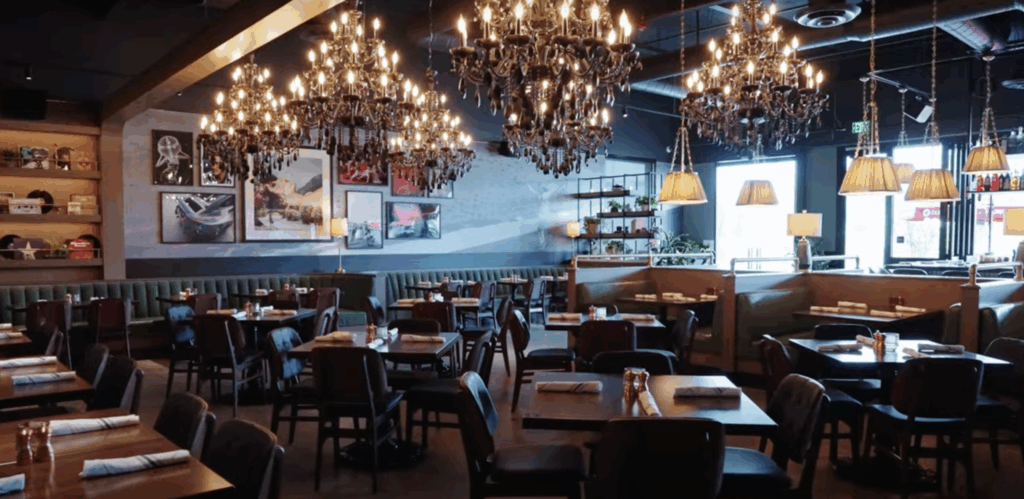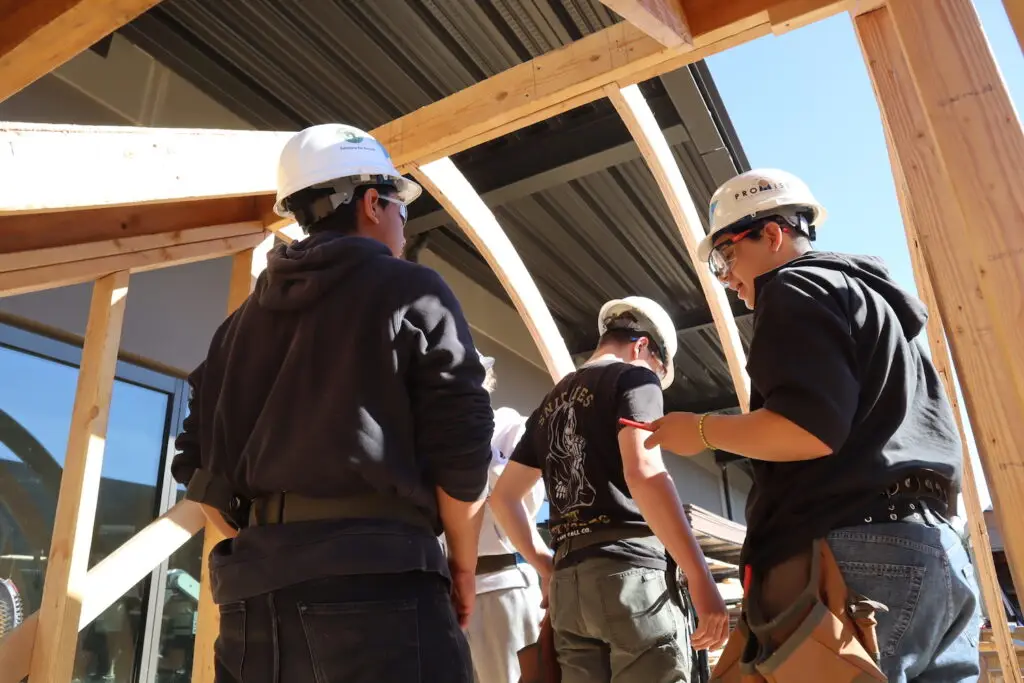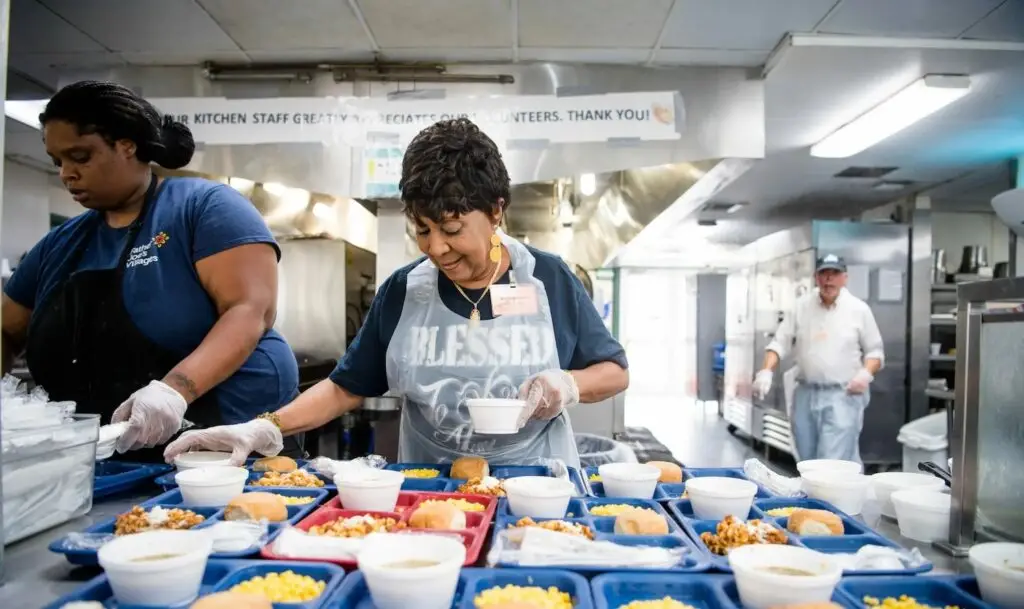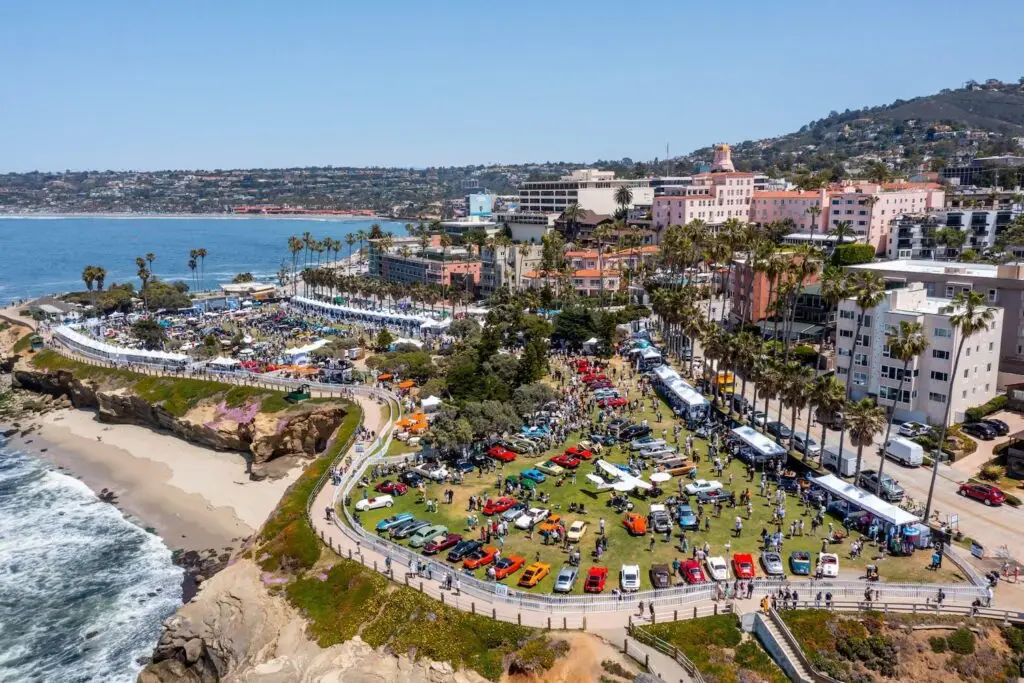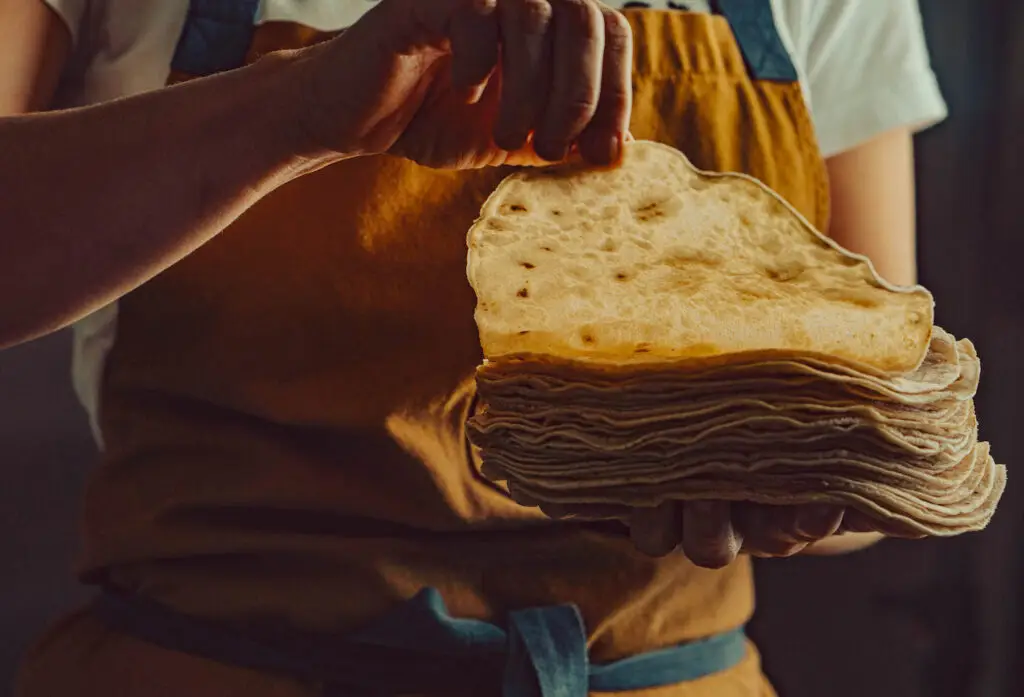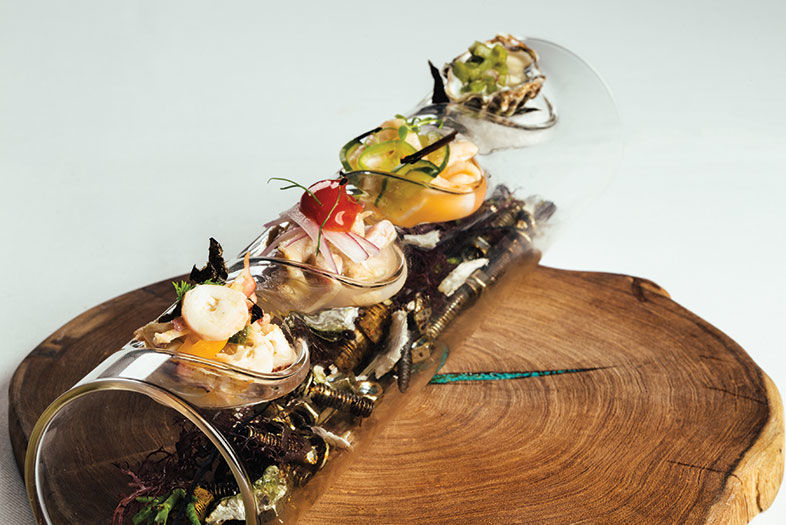In eight short years, Baja’s gone from a virtual dead zone to one of the globe’s top food and drink destinations. With the world watching, how will innovators in Tijuana and Valle de Guadalupe handle growing crowds and attention—without selling their souls?
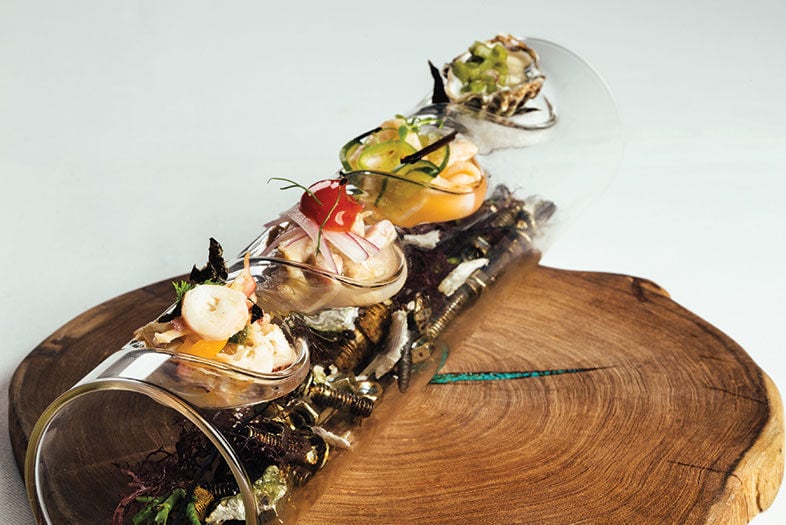
The Baja Moment
Misión 19’s trio of local ceviches over a bed of rusty nails and seaweed, a tribute to a local beach.
Misión 19’s trio of local ceviches over a bed of rusty nails and seaweed, a tribute to a local beach.
That smell has always saddened me. That’s Tijuana’s handshake to the world—a pungent spritz of sewage? The Tijuana River Basin runs under the San Ysidro border crossing, carrying a flotilla of discarded grossness. Most tourists like their travel destinations more redolent of spa eucalyptus. The smell is why some of them don’t come here.
“Tijuana’s not for everybody, and that’s okay,” says Derrik Chinn, an American journalist who’s lived there since 2007. Chinn owns Turista Libre!, leading gringos on cultural excursions through Tijuana. When he started, Mexican cabbies threw rocks at his bus. In September, the TJ newspaper hailed his contribution to the city.
“The city’s been a tourist trap since Prohibition,” he says. “The drug wars and border waits gave the city a much, much-needed chance to define itself for itself. The tourists weren’t coming. What if they never came back?”
Prohibition is why Tijuana became what it became. Hollywood A-listers came here to gamble at Caliente, watch bullfights on acid, escape America’s crushing sobriety. Preachers called it “Satan’s Playground.” By the ’80s, Avenida Revolucion was a prolific vice market made grotesque by the drastic socioeconomic divide between the sellers and the buyers. It was the place to get drunk, drugged, mugged, prostituted, marginalized, corrupted, blasphemed, kidnapped, and thrown in a moldy jail forever and ever.
Of course, that was always part of Tijuana’s allure—fear being the catalyst for pleasure that it is.
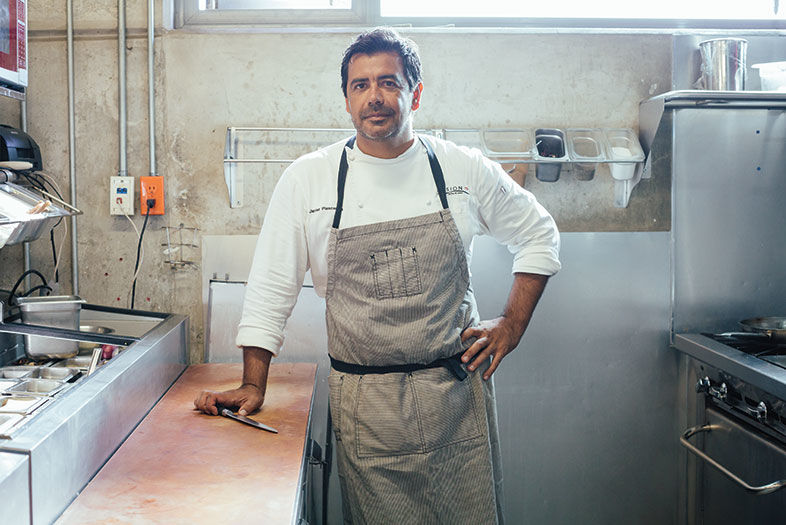
The Baja Moment
Chef Javier Plascencia
Chef Javier Plascencia
Then Nortec Collective happened. In 1999, this small army of Tijuana DJs, musicians, and artists became internationally famous. Art stole the spotlight back from the donkeys painted like zebras (zonkeys).
Then there was blood. In 2006, the Mexican government stopped partying with the cartels and started arresting them. With a power vacuum created, aspiring cartels fought in the streets over the lucrative crime market. American media peeked over the fence and inflamed the scene even more.
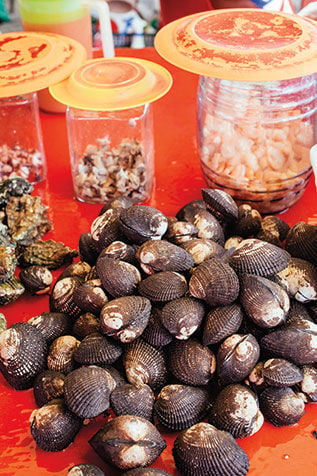
The Baja Moment
“Raining Machetes in Mexico!”
“How to Survive A Battery Acid Attack in TJ!”
Americans overreacted and wrote off the entire country. Like someone from Mexico City saying, “Sorry, niños. There’s murder in Chicago. No Disneyland this year.”
Now, the dust has settled and Baja is one of the most buzzed-about culinary destinations on the planet. Anthony Bourdain, Andrew Zimmern, and Rick Bayless are praising it on TV. The Wall Street Journal is taking it seriously enough to critique the region’s wines. This year’s esteemed S. Pellegrino list of Latin America’s Top 50 Best Restaurants included two in Baja.
A couple years ago, star Tijuana chef Javier Plascencia told the New Yorker and the New York Times he wanted to see Baja become an international food destination one day. Just like San Francisco or Mexico City.
That day is now.
Tijuana’s most brilliant tourism initiative seems to have been ignoring tourists. By doing so, they created an exciting native culture that’s attracting a more sophisticated breed of visitor.
“People are open to seeing Tijuana less as a tourist, and more as a traveler,” Chinn suggests. “As a tourist, the city is adapting to you. As a traveler, you’re adapting to the city.”
This time, chefs were the Nortec Collective—cultural ambassadors luring foreigners back to Mexico. Famed chefs like Benito Molina (Manzanilla), Diego Hernandez (Corazon de Tierra), and Miguel Angel Guerrero (La Querencia) cooked at events in the U.S. Jair Téllez—often called the Thomas Keller of Baja—helped design the menu at former San Diego restaurant El Take It Easy. Top San Diego restaurants have added Baja Med dishes (grilled octopus, tiraditos, gourmet tostadas, etc.).
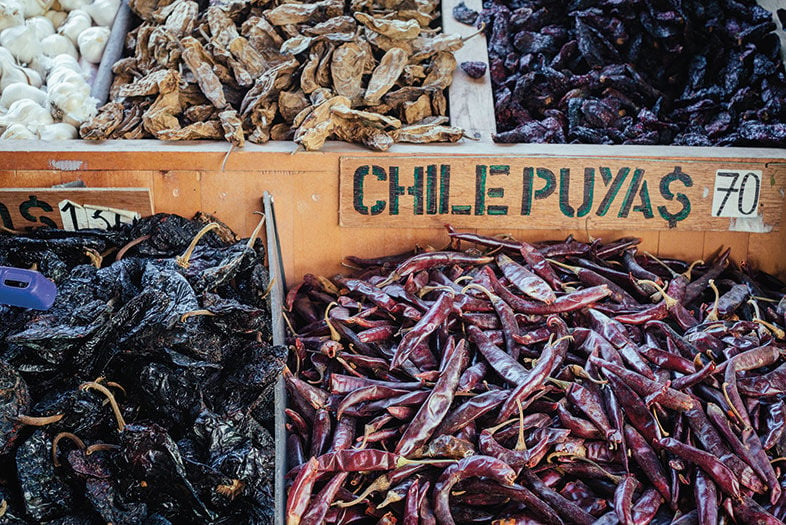
The Baja Moment
Baja California’s wealth of locally caught seafood and farmers market produce is helping spur a culinary renaissance.
Baja California’s wealth of locally caught seafood and farmers market produce is helping spur a culinary renaissance.
A lot of credit has deservedly gone to Plascencia. The chef was raised on both sides of the border. He’s bilingual. He looks like a Mexican George Clooney. Most importantly, he can really cook. He is the gateway.
Plascencia helps his father, Juan Jose, run Grupo Plascencia, one of Tijuana’s largest restaurant groups. In 2007, the kidnapping epidemic forced Plascencia to relocate his family to Chula Vista, where he opened Romesco Baja Med. He helped manage his TJ restaurants via camera on his computer. When he ventured into Mexico, he rode a motorcycle with a dark helmet for disguise. He brought Baja chefs north, and took American friends on taco tours of Tijuana.
“People ask why I bring all these gringo chefs down,” he tells me before the annual Vendimias wine harvest dinner at Finca Altozano, his outdoor restaurant in Valle de Guadalupe. It’s a six-course collaborative feast with Mexican chefs, former French Laundry chef de cuisine Timothy Hollingsworth and San Diego’s Jon Sloan (Juniper & Ivy). “Because they spread the word,” he says.
Later this year, Plascencia will open Bracero in Little Italy. It will be his biggest San Diego restaurant yet—a celebration of Baja food and drink. It will spread the word.
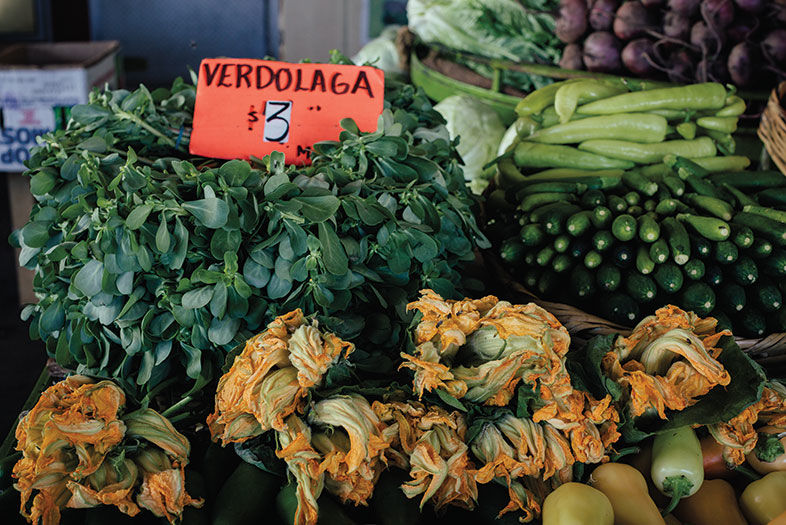
The Baja Moment
At Tijuana’s central farmers market, Mercado Hidalgo, there are mole sauces in buckets, honeycomb, dried fruit, chiles in every imaginable form, an orgy of produce. There’s lemongrass and bok choi, a nod to the large Asian population who came to America to work the railroads and fled to Tijuana to avoid persecution.
“Ask locals for their favorite restaurant and seven times out of 10 it’ll be a Chinese place,” Plascencia laughs, pointing out the heavy Asian influence in Baja cuisine (the fish in fish tacos is tempura-battered).
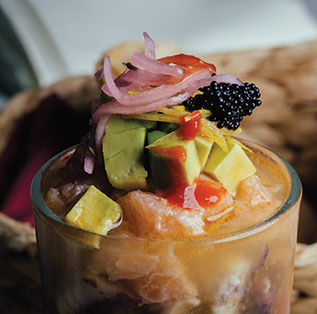
The Baja Moment
Ceviche with octopus and dorado, topped with caviar.
Baja is an ingredient goldmine. The soil rivals California’s for top-notch, year-round produce. The Sea of Cortez supplies mussels, octopus, spiny lobster, bluefin tuna, chocolate clams—almost every aquatic delicacy. Ensenada’s olive oil is world-class.
“Produce grows the best here,” says chef-hunter-fisherman Guerrero, a fourth-generation Tijuana native who opened La Querencia in Rosarito in 2001. He’s since expanded with El Taller in Tijuana and Almazara Gastrobar in Valle de Guadalupe, and a new concept at the massive L.A. Cetto winery in the Valle.
Guerrero trademarked the term “Baja Med.”
So what is Baja Med? Very effective marketing. Just like Puebla is famous for mole and Jalisco for tequila, Baja needed a food identity. Outsiders largely viewed Mexican food as inexpensive, hastily made, to-go cuisine. The word “Med” (for Mediterranean) simply elevated its cultural cache. Plus, Baja has a warm, seaside climate like towns along the Adriatic Sea. Dishes are often cooked using wood and smoke, chiles, local vegetables and seafood, prepared with a mix of Mexican, French, Italian, and Asian techniques. Tourism officials are looking to get “Baja Med” registered as an official, geographically protected phrase.
“I fish, I dive, and I hunt,” says Guerrero via phone from a fishing tournament. “Whatever I catch I put on my menu.”
That’s another perk. Baja chefs are unburdened by the USDA. It’s illegal for American chefs to hunt-and-serve. Mexico’s famed lawlessness has been a boon for gourmet foods like house-made cheese, chorizo, and charcuterie.
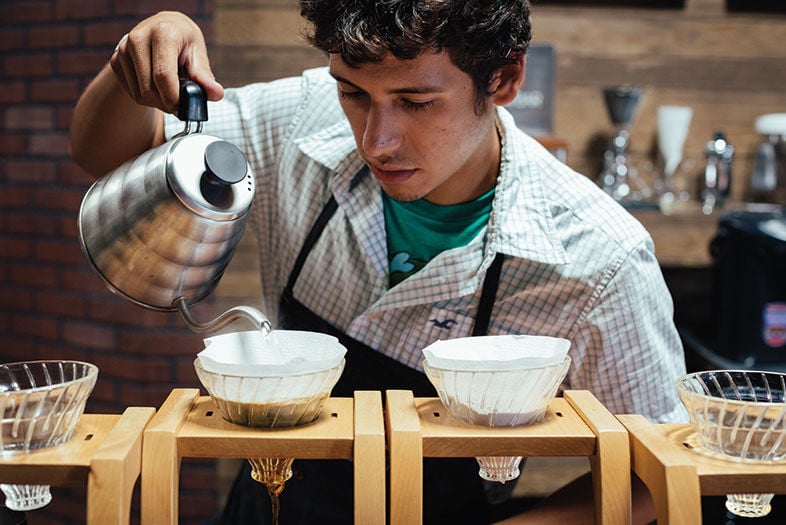
The Baja Moment
Third wave pour-over, Caffe Sospeso.
Third wave pour-over, Caffe Sospeso.
At Caffe Sospeso, Tijuana has its own Third Wave coffee shop, like Blue Bottle in the Bay Area or San Diego’s Caffe Calabria. I share a glass of their thick, naturally sweet cold-brew with Javier González, director of the Culinary Art School. When it first opened in 2003 with 32 students, there was no cooking school in Tijuana. Now they have 225 students, and Tijuana has approximately 10 cooking schools. González says 70 percent of graduates—like Diego Hernández and Martin Vargas of Tijuana’s top new restaurant, Verde Y Crema—are now staying in Baja instead of leaving for American food cities like San Diego or New York.
“A couple years ago, fine dining in Tijuana was just French food,” explains Vargas, who says the school is a boon for Baja’s food scene. “Now we’re focusing on what we have here.”
Other graduates are starting their own food carts, inspired by the popular street-food vendors at Food Garden—home to Tacos Kokopelli, Los Chilaquiles, and La Taqueseria. “Mexicans are very used to eating in the streets. We’ve done it our whole life,” González explains. “Street vendors and food trucks are the first step in educating people about good food. They try truffle fries for the first time there, and then they go to a restaurant.”
Street food has captured America’s eye, too. But a fleet of food trucks in a Walmart parking lot lacks the sense of place you feel at the string of taco huts at Las Ahumaderas, the al pastor at Tacos El Franc, or carne asada sandwiches at Tortas WashMobile.
“This city is only 125 years old,” says Gonzalez. “When I got here 11 years ago, most people weren’t from Tijuana. They were from Sonora, Jalisco, Oaxaca—just trying to jump into the U.S. to chase the American dream. The streets were dirty. They didn’t feel proud of Tijuana. They’d say they were from Baja, not Tijuana. When they didn’t make it to the U.S., they stayed here. They developed a relationship with the city. Now they defend Tijuana.”
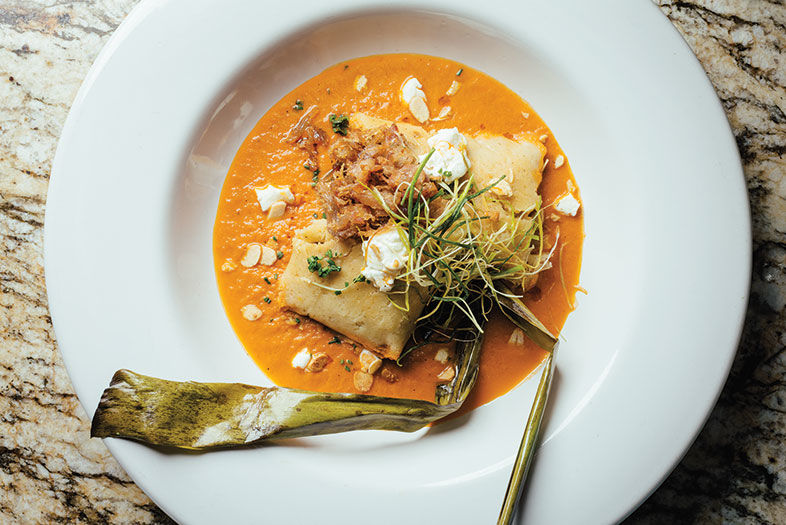
The Baja Moment
Local lamb tamale from La Querencia.
Local lamb tamale from La Querencia.
Perched atop the Via Corporativo building—Baja’s first LEED-certified structure—Misión 19 is a source of pride. This is Plascencia’s showroom for modern Baja cuisine, like bone marrow with avocado meringue. Or a trio of local ceviches suspended over a bed of rusty nails and seaweed (an ode to the nearby beach at Popotle). Plascencia says about 60 percent of Misión 19’s customers are Americans.
State Tourism Minister Oscar Escobedo is a regular customer.
“Chefs realize they have the most desired species of seafood here, including lobster, abalone, and bluefin,” he says. “We’re the second greatest producer of grape tomatoes in the world, and first for strawberries. Our wines have won over 1,000 gold medals. It helps that we have the French in Ensenada with their pastries, our Mexican food, Chinese in Mexicali. These kids make the fusion food called Baja Med—a taco made out of duck.”
The government has helped Baja food. At Plascencia’s urging, Tijuana created the Distrito Gastronómico, a restaurant row with a well-paved walking route. The Baja government flies Miguel Angel Guerrero to Korea, Japan, England, Spain, and Israel as an ambassador for Baja Med. The state also designed a “Ruta del Vino,” a sign-posted route through the Valle de Guadalupe wine region.
I ask Escobedo what holds Baja’s food scene back.
The border, he says. The northbound San Ysidro Port of Entry is the western hemisphere’s busiest, with an average of 50,000 cars a day. Up until recently, it could be up to a three- or four-hour wait.
As part of a $741 million overhaul (set for 2018 completion), 25 northbound lanes were opened in September, most serving two cars at a time. That’s reduced the wait, at least for now. But Escobedo would like to do more—granting high-value visitors access to express lanes, much like Mexico does for medical tourists.
Dinner at Misión 19? Express lane for you.
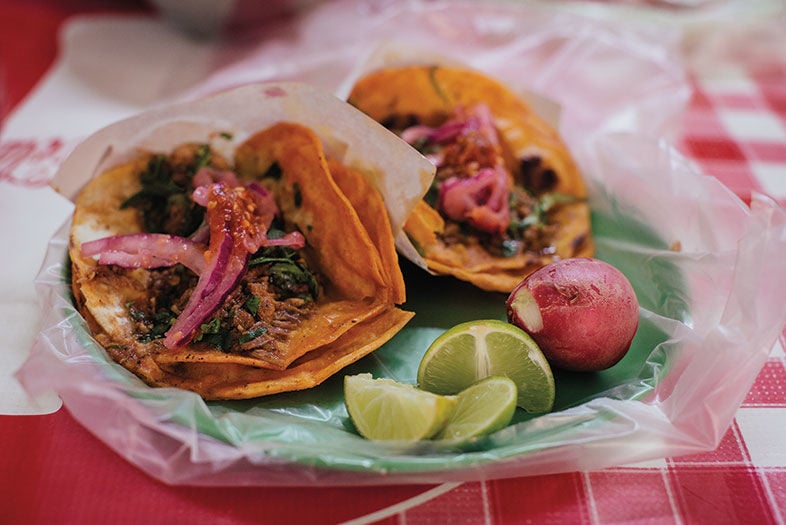
The Baja Moment
Beef birria street tacos from tijuana’s Birria De Res.
Beef birria street tacos from tijuana’s Birria De Res.
Mexico isn’t just courting American tourists. Tijuana is the only city in Latin America with a direct flight to China (originally created to export Baja’s produce to Shanghai). “There are more English speakers in China than there are in America,” Escobedo says. Next year, he plans to heavily promote the craft beer scene.
After a long battle against a government-enabled monopoly, Baja craft beer is primed for its own big moment. Until earlier this year, Mexico allowed the top two brewers—FEMSA (Tecate) and Grupo Modelo (Corona)—to monopolize the country’s liquor licenses. The brewers granted them to bar owners who agreed to serve their beer exclusively.
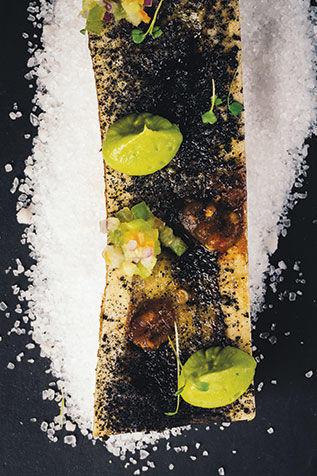
The Baja Moment
Roasted beef bone marrow and avocado meringue, Misión 19.
“They changed that law—they can’t have exclusivity anymore,” explains Damien Morales of Cerveceria Insurgente, whose three-story brewery and tasting room is nearly ready in downtown TJ. “Our business has quadrupled. There are probably 50 breweries in Tijuana now, mostly nano-breweries.”
Damien and his brother, Iván—along with breweries like Border Psycho, Wendlandt, Agua Mala, and Mamut, plus bars Beer Box, BCB, and Sotano Suizo—are leading the craft beer scene. Insurgente won three gold medals at the country’s top beer competition.
As Baja’s craft beer emerges, its wine region has arrived. To reach Valle de Guadalupe, we drive down the coastal toll road, past Rosarito and Querencia, past the 75-foot Jesus statue, past the famous lobster village of Puerto Nuevo, and—run into a huge hole in the earth. Last December, the main road to Ensenada collapsed 100 feet from the ocean. It’s still not fixed.
That means, at the height of foreign interest in modern Baja cuisine, the road impairs travelers from reaching what many consider its birthplace—Restaurante Manzanilla in Ensenada. It was there in 2000 that chef Benito Molina created his world-class Baja restaurant using all local ingredients.
“There was a wine movement here, but local ingredients were being exported to the rest of Mexico and the U.S.,” explains Solange Muris, Benito’s wife and Manzanilla’s co-owner, co-chef, and co-star on their TV show, Benito y Solange. “The cooks were using foie gras and truffles.”
This year, Manzanilla was ranked No. 25 in S. Pellegrino’s list of Latin America’s Top 50 Restaurants. I ask when she expects the road to be finished. (There is a detour, but it is much slower.) She laughs: “I stopped believing in Santa Claus.”
She and Benito also operate Silvestre, one of the many temporary restaurants during Valle de Guadalupe’s harvest season. “The Valle” is a delicate, divisive subject. Every local has an idea of how to deal with its newfound fame.
“I understand that everyone thinks it’s super cool to have a restaurant in the Valle,” says Muris, flatly. “But we have to be careful. We don’t want a McDonald’s.”
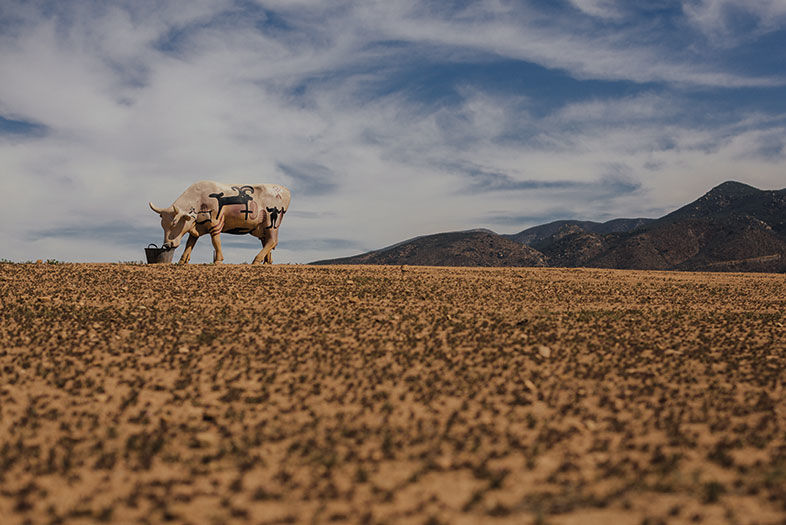
The Baja Moment
Finca Altozano.
Finca Altozano.
Like Valle de Guadalupe’s most impressive wineries, Encuentro Antiresort (the former Hotel Endemico) intentionally straddles the line between art and dirt. There are no well-lit hallways. Just 20 stand-alone studios atop stilts, nestled into the hills. The front desk gives you a flashlight. It’s you, a clay urn full of firewood, and those famous Baja stars.
The Valle below looks like someone planted grapes on the moon. Fitting, since the Valle is just about as dry.
Located 40 minutes northeast of Ensenada, 90 percent of Mexico’s wine comes from these 8,500 acres, accessible by a series of dirt roads. Wine Enthusiast recently named it one of the wine world’s top 10 travel destinations. Developers are crafting plans. Elder residents are protesting them. Last year, locals barely thwarted a shady, closed-door vote to approve a 996-acre Miami-style condo development.
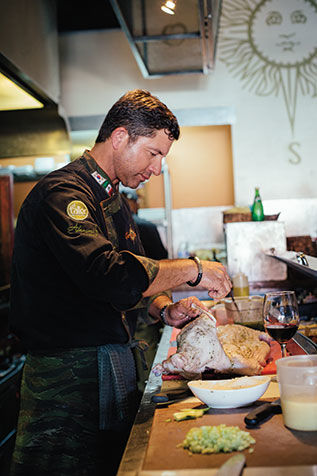
The Baja Moment
El Taller’s chef Miguel Angel Guerrero prepares a suckling pig.
In the ’70s, the Valle was dominated by three big wineries: L.A. Cetto, Domecq, and Santo Tomas. Then the economy sank. The wineries stopped buying grapes from locals. Residents abandoned their vineyards and their homes. The big wineries survived; the community did not.
Hugo D’Acosta made sure that wouldn’t happen again. Raised in Mexico City and trained in Bordeaux, D’Acosta taught local growers how to make their own wine in the late ’80s. That turned them into businessmen, which helped turn the Valle into what it is now—a basin full of more than 100 small-scale, independent wineries, including D’Acosta’s Casa de Piedra. That decentralization helps stabilize the local economy.
Some call D’Acosta the Mexican Mondavi. (Every icon here seems to have a “The Mexican _____” moniker, assigned by American media).
The Valle has always been a sort of a culinary migrant camp. Chefs from Tijuana, Mexico City, or Cabo set up campestre restaurants for the summer tourist season. But in 2001, Tijuana chef Jair Téllez (“The Mexican Thomas Keller”) opened Laja in a single-story house at the end of a dirt road—and never closed. Téllez had worked under Daniel Boulud in New York and Roland Passot in San Francisco. He lived in the back of Laja and served four- and eight-course French-inspired tasting menus in the front.
“I wanted to find my place with my people,” he says. “So I created a destination restaurant. We didn’t take tables larger than 10. We didn’t do events. We didn’t have chips and salsa. But it worked.”
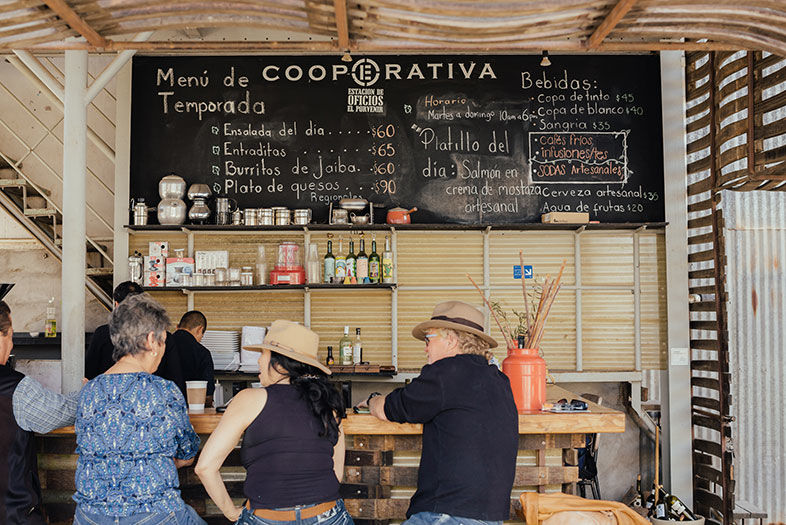
The Baja Moment
The bar at La escuelita in Valle de guadalupe, a wine school and incubator set up by hugo d’acosta to teach locals how to make their own wine.
The bar at La escuelita in Valle de guadalupe, a wine school and incubator set up by hugo d’acosta to teach locals how to make their own wine.
For six years Téllez created tirelessly—sometimes for a packed dining room, sometimes for solace. In 2008 he left Laja in the hands of friend/cook/sommelier Andres Blanco, and went to Mexico City to open MeroToro. He returns to Laja once a month. Last year, both restaurants made S. Pellegrino’s list.
The Valle’s recent tipping point seems to have been 2011, with the arrival of three prominent chefs. Phil and Eileen Gregory (retired Brits with ties to the Eurythmics and the recording industry) partnered with chef Diego Hernández for Corazon de Tierra, an indoor-outdoor restaurant at their bed-and-breakfast La Villa del Valle. Beneath some pine trees on one of the oldest wineries, Mogor-Badan, Michelin-starred chef Drew Deckman set up what is essentially a gourmet campsite (Deckman’s en el Mogor). And Plascencia opened Finca Altozano.
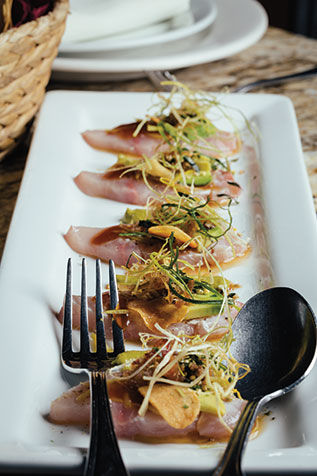
The Baja Moment
Locally caught dorado topped with beef bacon, La Querencia.
“The plan was to have a two-month sabbatical,” explains Deckman, who worked under legendary chefs Paul Bocuse and Jacques Maximin. “I started with 30 seats. Now I’ve got 85. The first year we stayed open two months. Last year it was six. This year we’re staying open year-round.”
While Deckman’s is statement minimalism, Finca is a pretty elaborate gourmet party compound. Three 15-foot fermentation tanks are topped with banquettes for private dining, or wine perches. Under a 70-foot oak tree, there’s a three-layer deck with lights for events. The plan is to build eight casitas on the property for people to stay a few days.
“Javier did Finca in a very Tijuana way—a smart, entrepreneurial way,” chuckles Téllez. On busy nights Finca will sell out, serving 500 guests. Yet Plascencia has reservations about growth, too.
“A lot of people aren’t coming to Vendimias this year,” he says of the Valle’s annual wine-harvest parties. “Tickets are now $150 to $200. People think it’s a little too snobby. At the big places, you have Kenny G playing and all this shit. The Vendimias should not be that.”
Deckman says when he opened, there were 23 restaurants in Valle de Guadalupe. Now he estimates there are 80-plus, not including taco stands. Plascencia’s estimate is closer to 50. Either way, it’s significant growth, which creates significant challenges.
“But there’s no more hotel rooms—just a lot more tables and chairs,” he says. “With the press the Valle’s getting, the wave is big and everyone’s riding it. I think it’s great. But some people show up with big eyes and then walk away a year later thinking, ‘Man, maybe I shouldn’t have sold my house in San Diego.’”
“We need the right growth, not no growth,” says Téllez.
“There’s a big discussion about how big the wine region could be with tourism—but I think the Valle should remain rural,” says D’Acosta, who cites last year’s meager 3.5 inches of rainfall (half the annual average). “We don’t have water for irrigation.”
I ask him about a quote T Magazine had attributed to him: “Good roads, bad tourists. Bad roads, good tourists.”
“It’s not that we don’t want good roads,” he clarifies. “But a filter helps get the right people here. When you have everything in your hands, you lose a bit of real perspective. In Acapulco and Cancún, tourists don’t care if it’s Mexico. People will come to the Valle because they like the people and we can show them the way we live—rather than becoming a server.”
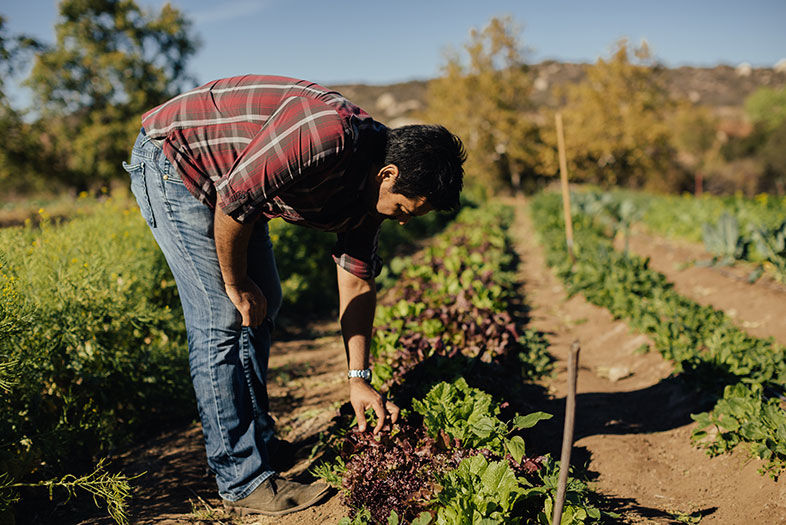
The Baja Moment
Plascencia in the garden at Mogor Badan
Plascencia in the garden at Mogor Badan
One of my sources tells me the big wineries—L.A. Cetto and Domecq—are working on a gastro village that includes a signature restaurant, cheese shop, art center, and bike shop. Homes (ranchitos) will be sold with their own vineyards included for somewhere around $2 million. The management company is rumored to be Auberge Resorts, which has three properties in Napa (Calistoga Ranch, VieVage, Auberge du Soleil) and Esperanza in Cabo San Lucas. Auberge declined to comment.
Is that growth—luxury residences with a focus on food, wine, and nature—the right kind?
One Valle icon says yes. Another says no. A third refers to it as “the Temeculization” of the Valle. Such is the Valle right now. It stands at a divided path, and the future is breathing down its neck.
Our time in the Valle is, as advertised, magical. There’s no sense of danger. We are not kidnapped or mugged or murdered. Our faith in Baja is enervated, restored.
About five minutes from the Tecate border crossing, we’re pulled over by a police officer. He claims we didn’t come to a complete stop and we’ll have to go with him down to the station. We pay him $60 and he bids us a good day. We then spend nearly four hours in a long, sweltering crawl through the line of cars crossing into the U.S.
Filters, I think.
